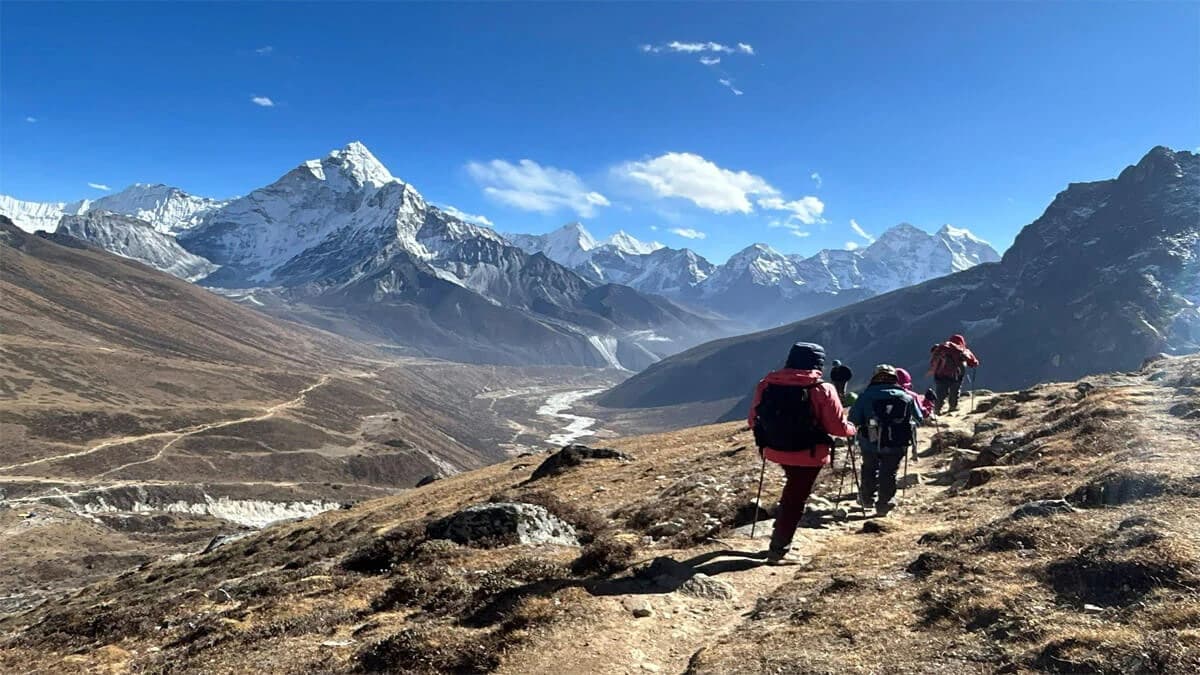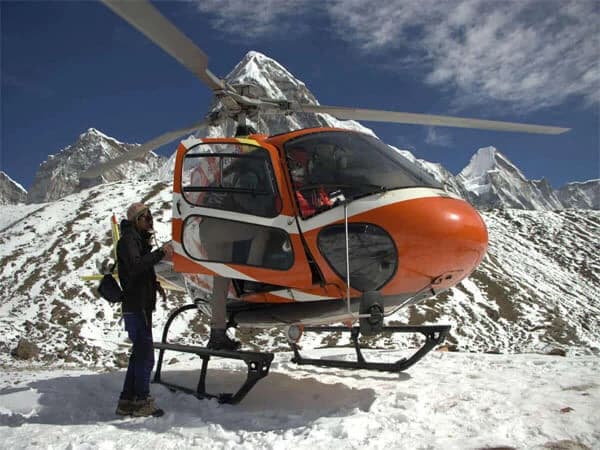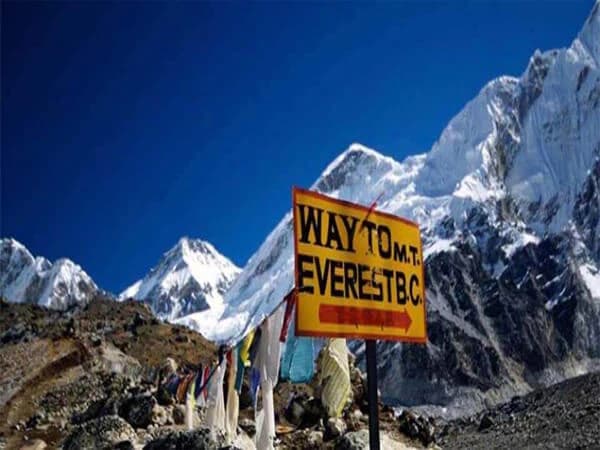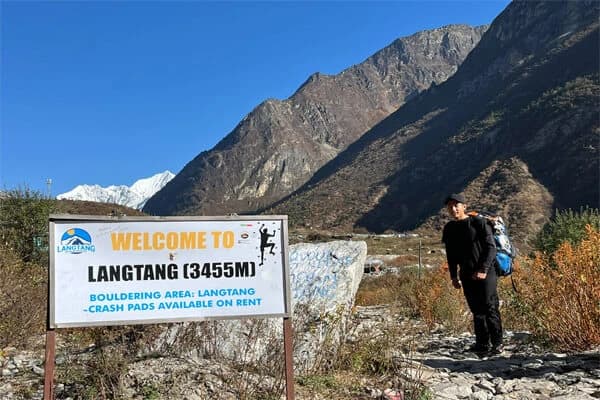If you are considering a trip to the Himalayas, one typical question is "When to do the Everest Base Camp sleeping trek?" Choosing the right season is critical for your safety, comfort, and overall pleasure. The trek combines high-altitude walking, variable weather, and inaccessible terrain, so timing is critical for visibility, trail conditions, and enjoyment.
The Everest Base Camp sleeping trek allows trekkers to enjoy amazing views of Mount Everest, Lhotse, Ama Dablam, and the surrounding peaks while staying in teahouses along the way. Unlike expedition-style climbs, this route prioritizes accessible trekking with good overnight stays, making it suitable for beginners, families, and those with limited time.
The timing of the trek has an impact on both the natural beauty and cultural experiences. Spring (March to May) brings flowering rhododendrons and comfortable temperatures, while autumn (September to November) brings clear skies and breathtaking mountain views. Winter is quieter yet cooler, while the monsoon season delivers verdant vistas with potential rain concerns.
In this blog, we will look at the optimum times to do the Everest Base Camp sleeping trek, taking into account weather, altitude, crowds, and scenic features to help you plan a safe and memorable Himalayan experience.
Everest Base Camp sleeping trek weather
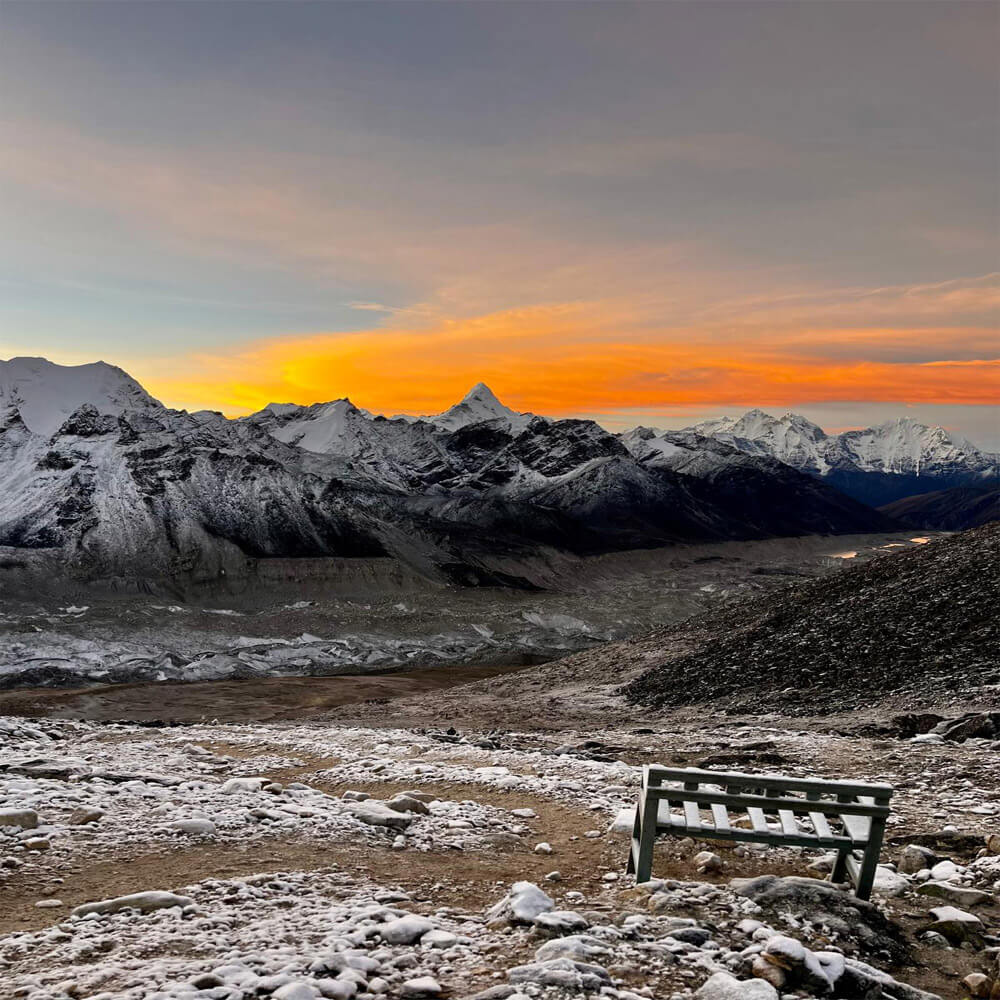
The weather on the Everest Base Camp sleeping trek is a major factor that influences the overall experience. Unlike a short day trek, this trek requires sleeping overnight at numerous tea houses and lodges along the way, so recognizing seasonal conditions is critical for comfort and safety.
The weather in the spring (March to May) is often pleasant and stable. Days are warm and clear, with great views of Everest and the surrounding peaks. Nights, however, can be rather cold, particularly over 3,500 meters, therefore warm sleeping clothing is required. Spring also corresponds with rhododendron flowers, which provide rich color to the paths.
This trek is best done in the autumn (late September to November). The sky are frequently clear, visibility is superb, and temperatures are slightly lower than in spring, making trekking more comfortable. Nighttime temperatures plummet, so insulated sleeping bags are needed.
Winter (December-February) brings harsh cold, heavy snowfall, and high winds, making the journey difficult and dangerous. Summer (June to August) coincides with the monsoon season, which brings rain, slippery trails, and landslides that can hamper overnight stays.
Understanding the weather is essential while planning for the Everest Base Camp sleeping trek. Trekkers can experience stunning Himalayan views while remaining comfortable and secure if they choose the correct season, clothing, and sleeping gear. This guide intends to assist readers plan their expedition.
What is the Best season for EBC sleeping trek?
The best seasons for the Everest Base Camp (EBC) sleeping trek are spring (March to May) and autumn (late September to November). In the spring, the temperature is normally pleasant, the skies are clear, and rhododendrons bloom along the pathways, providing a colorful and scenic experience. Autumn provides consistent weather, crisp air, and superb visibility of Everest and its neighboring peaks, making it ideal for photography. Nights are cold in both seasons, therefore good sleeping clothing is required. These seasons avoid significant snowfall in winter and monsoon rains in summer, resulting in safer pathways and more comfortable overnight stays.
Best months for Everest Base Camp Sleeping trek?
The optimum months to trek to Everest Base Camp are March to May and late September to November, which coincide with Nepal's spring and autumn seasons. These months offer the best circumstances for visibility, safety, and overall trekking comfort.
Everest sleeping trek in Spring (March to May) sees the weather gradually warm up after winter, bringing sunny sky and comfortable daytime temperatures. This season is most known for the blooming rhododendrons, which give brilliant reds and pinks to the landscape. Nights are cold, particularly above 3,500 meters, so adequate sleeping equipment and thick clothing are required. Spring also brings less clouds and better mountain visibility, making it ideal for photographing stunning vistas of Everest, Lhotse, and other towering peaks.
The monsoon rains of autumn (late September to November) have cleansed the dust and haze, leaving crisp air and crystal-clear skies. This is the most popular trekking season since the paths are dry, the weather is consistent, and the views from the mountains are breathtaking. Temperatures are slightly lower than in spring, but daytime trekking is still acceptable, while evenings are cold, necessitating insulated sleeping gear.
The Everest sleeping trek in winter season (December to February) bring significant snowfall and intense cold, but the summer monsoon (June to August) brings rain, slippery pathways, and landslides. Choosing spring or autumn allows for a safer, more scenic, and pleasurable Everest Base Camp trekking trip.
Everest Base Camp trek temperature and conditions
The temperature and conditions on the Everest Base Camp (EBC) trek vary drastically depending on the season, altitude, and time of day, so preparation is critical for a safe and enjoyable journey.
During spring and autumn, daytime temperatures in Lukla (2,800 m) and Namche Bazaar (3,400 m) typically range between 15°C and 20°C, but nights can drop to 5°C or lower. Temperatures decrease substantially above 4,000m, with daytime temperatures around 0°C and nighttime temperatures ranging from -10°C to -15°C in higher communities like Dingboche and Lobuche. Temperatures near Everest Base Camp (5,364 m) can be below freezing during the day and -20°C or lower at night, particularly during winter.
In spring and autumn, weather conditions are generally consistent, with bright sky providing stunning views of Mount Everest and the neighboring peaks. Winds can be severe at higher elevations, and unexpected weather changes, such as snow or hail, are typical. Summer brings monsoon rains, making paths slippery and less safe, and winter is exceedingly cold, with heavy snowfall and fierce winds that make trekking dangerous.
Layered clothing, appropriate insulation, and a high-quality sleeping bag are required when trekking to EBC. Understanding these temperature ranges and conditions allows trekkers to plan safe daily excursions, rest stops, and overnight stays while fully enjoying the Himalayan landscape.
Sleeping altitude for Everest Base Camp trek
The sleeping altitude during the Everest Base Camp (EBC) trek is an important factor for anyone contemplating this adventure. Unlike a day climb, this trek requires many nights at increasingly higher elevations, allowing the body to acclimate and lowering the danger of altitude sickness.
Trekkers typically begin at Lukla (2,860 m) and spend the first night at Phakding (2,610 m) or Namche Bazaar (3,440 m). Overnight stops on the journey gradually increase in elevation, reaching Tengboche at 3,860 m, Dingboche at 4,410 m, and Lobuche at 4,940 m. Before reaching Everest Base Camp (5,364 m), many trekkers spend their final night at Gorak Shep (5,164 m), a little village near the Khumbu Glacier.
Sleeping at high elevations necessitates thorough preparation. Insulated sleeping bags and thick clothing are important when temperatures drop below freezing, especially above 4,000 m. Tea houses have minimal heating, but it is typically limited. Staying hydrated, eating well, and rising gradually are essential for avoiding altitude sickness.
Understanding the sleeping altitude is critical to both safety and comfort. Trekkers can enjoy overnight stays with beautiful Himalayan vistas by pacing the ascent and selecting adequate gear, allowing their bodies to adjust to the increased height. This information contributes to the EBC sleeping trek gratifying and memorable experience.
High altitude sleeping difficulty Everest Base Camp trek
Sleeping at high altitudes during the Everest Base Camp (EBC) trek can be difficult for many trekkers. The body needs time to adjust to decreasing oxygen levels, which frequently impairs sleep quality. At elevations exceeding 3,000 meters, oxygen saturation drops, resulting in shortness of breath, restlessness, and frequent awakening during the night. Many trekkers report lighter sleep and vivid dreams, and some have difficulty falling asleep, a condition known as "high-altitude insomnia."
Altitude sickness is another element that influences sleep. Headaches, nausea, and dizziness can make it difficult to rest. Acclimatization is essential for trekkers should ascend gradually and take rest days at key places like Namche Bazaar and Dingboche to allow their bodies to adjust.
Sleeping arrangements play an important impact. Tea houses along the trail are comfortable, but they can be cold at night, typically below freezing, and the thin walls may allow for noise from other trekkers. Carrying a warm, insulated sleeping bag suitable for sub-zero conditions is critical for both comfort and safety.
Hydration and light meals before bedtime can assist, but alcohol and heavier foods should be avoided because they can exacerbate sleep problems. Understanding and preparing for these risks makes the EBC journey safer and more relaxing.
Everest Base Camp sleeping trek preparation
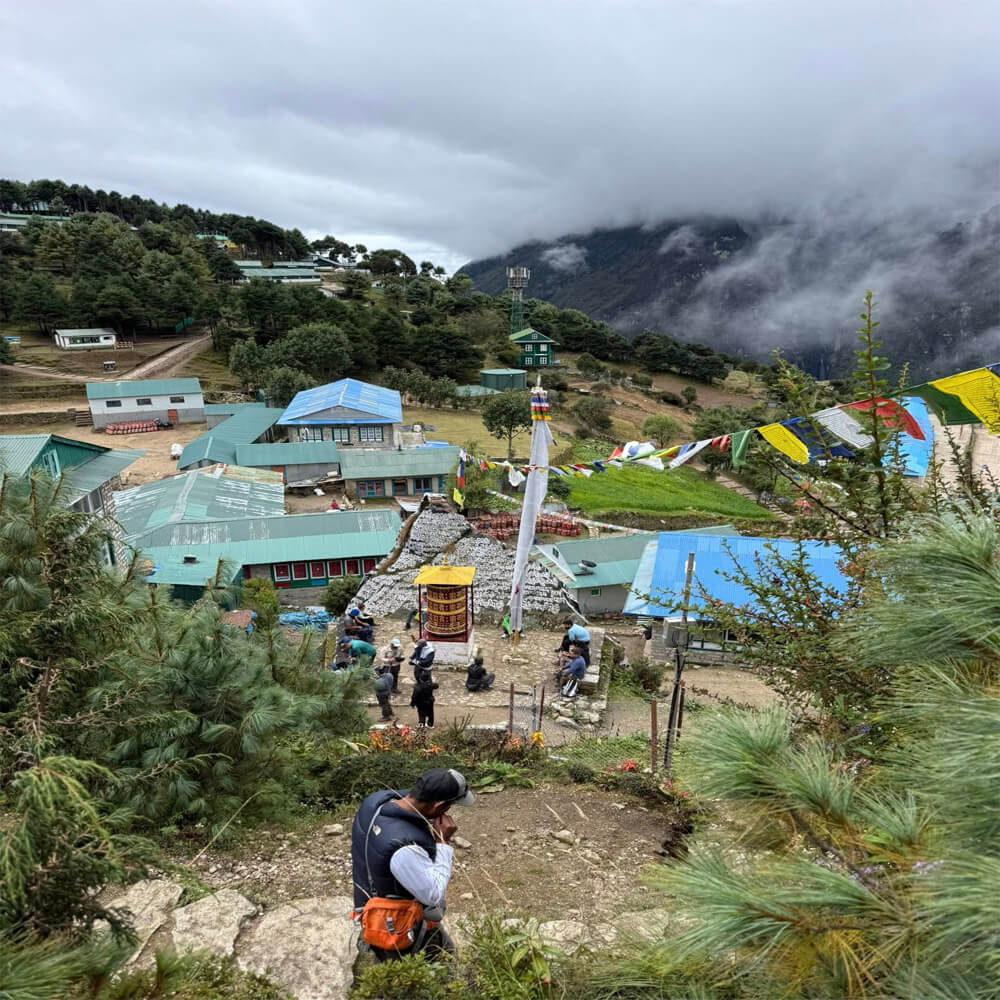
Preparing for the Everest Base Camp (EBC) sleeping trek takes meticulous planning because it involves traveling at high altitudes and staying overnight in tea houses along the way. Physical preparedness is the first step. Trekkers should engage in regular cardiovascular exercises such as trekking, jogging, or cycling for at least 6-8 weeks prior to the trip. Strength training, particularly for the legs, core, and back, is essential for enduring long days of backpacking.
Packing the appropriate equipment is critical. Layered gear, a warm sleeping bag, a waterproof jacket, durable trekking boots, and thermal innerwear are essential. Remember to pack a headlamp, trekking poles, water bottles, and personal first aid supplies. Proper hydration and acclimatization are also important. Trekkers should schedule rest days and progressively ascend to decrease the danger of altitude sickness.
Mental preparation, while frequently ignored, is just as crucial. The trek can be physically and emotionally taxing, with uncertain weather and lengthy walking days. Maintaining a positive attitude and flexibility with planning leads to a more enjoyable encounter.
Finally, recognizing local conditions, booking tea rooms ahead of time if possible, and planning for a reputable trekking company, such as Nepal Trekking Routes, will help with logistics. With careful planning, the EBC sleeping trek becomes a safe, memorable, and rewarding Himalayan adventure.
Comfortable sleeping options Everest trek
When planning the Everest Base Camp (EBC) sleeping trek, comfort at overnight stays is equally crucial as the trek itself. Most trekkers stay in teahouses and lodges along the way. These inexpensive guesthouses offer plain rooms with two single beds or a double bed, a blanket, and, perhaps, a pillow. While the rooms are comfortable, heating is frequently restricted, so carry a warm sleeping bag suitable for sub-zero temperatures, especially over 3,500 meters.
Some tea establishments have attached facilities, but in many cases, bathrooms are shared, and hot water is limited or priced separately. It is advisable to include sanitary supplies, hand sanitizer, and quick-dry towels.
Deluxe or premium lodges are available in key locations such as Namche Bazaar, Tengboche, and Dingboche for trekkers looking for a higher level of comfort. These provide larger rooms, better bedding, and occasionally wifi or tiny cafes.
Another recommendation is to reserve accommodations ahead of time during busy seasons (spring and autumn), as tea houses tend to fill up quickly. Simple comforts, such as a heated sleeping bag, dry clothes, and a lightweight pillow, can help you sleep well.
With careful planning, overnight arrangements on the EBC trek can be surprisingly comfortable, allowing trekkers to fully recover for the following day's Himalayan adventure.
Everest Base Camp trek temperature by month
The temperature on the Everest Base Camp (EBC) trek changes dramatically throughout the year, depending on both altitude and season. Understanding monthly temps helps trekkers plan their clothing, equipment, and the optimum time to visit.
January and February are the coldest months. Temperatures in Namche Bazaar (3,440 m) range between 0-5 °C during the day and -15 °C or lower at night. At Everest Base Camp (5,364 m), temperatures can drop to -20 °C throughout the night. Snowfall is prevalent, and strong gusts exacerbate the cold factor.
March-May (Spring): Lower regions get milder days ranging from 10-15 °C, but nights average around -5 °C. Temperatures can drop to -10 °C at night over 4,000 m. Spring brings sunny skies, improved trekking conditions, and blossoming rhododendrons.
During the monsoon season (June-August), daytime temperatures can range from 12-18°C in lower locations. Nights are milder, with temperatures ranging from 0 to 5°C. Heavy downpour, slick pathways, and cloud cover all reduce visibility of the mountains.
During September-November (Autumn), temperatures in Namche and lower regions range from 10-15 °C during the day and -5 °C to -10 °C at night. At higher altitudes, nights can reach -15 °C. This season provides consistent weather, bright skies, and excellent trekking conditions. December brings cold weather, similar to January, with sub-zero evenings and probable snowfall, particularly over 4,000 m. Because of the temperature fluctuations, proper clothing and sleeping gear are required all year.
What is the Best time for Everest Base Camp Sleeping Trek?
Sleeping at Everest Base Camp is a completely unique experience, but the timing of your visit can have a significant impact on comfort, safety, and enjoyment. The best times for Everest base camp sleeping trek to do so are in the spring (March to May) and autumn (late September to November), when the weather is most conducive.
Following a long winter, the region begins to warm up in April. The days are generally pleasant, with bright sky offering amazing views of Everest and the surrounding peaks. Nights continue cold, frequently plunging well below freezing at higher elevations, so a high-quality sleeping bag is required. The blossoming rhododendrons along the lower paths are one of spring's highlights, adding bursts of color to the trek.
Autumn is similarly popular, because to its consistent weather, low humidity, and crisp, clean air. This season provides the highest visibility in the Himalayas, making it ideal for photography and panoramic mountain views. The temperatures during the day are reasonable for trekking, but the nights at EBC trekking are still very chilly, emphasizing the importance of good insulation when sleeping.
Winter (December–February) brings harsh cold and significant snowfall, making overnight stays dangerous. Summer (June to August) corresponds with the monsoon season, which brings rain, landslides, and treacherous paths, potentially disrupting trekking plans. Planning your overnight journey for spring or autumn ensures a safer and more pleasant experience at Everest Base Camp.
Everest Base Camp trek spring vs autumn
The decision between spring and autumn for the Everest Base Camp (EBC) trek is mostly based on your priorities, such as colorful scenery, consistent weather, or trekking comfort.
Spring (March-May) is one of the most popular seasons for trekking. The climate is typically pleasant, with warm days and cool nights. One of the main attractions is the rhododendron bloom, which colors the paths in red, pink, and orange, providing a beautiful touch to the trekking experience. Spring also has slightly fewer busy trails than autumn, making for a more tranquil journey. However, temperatures at higher altitudes can remain frigid, and pre-monsoon rains are possible, particularly in late May.
Autumn (late September to November) is considered the most stable and safest season for trekking. The sky are frequently clear, allowing for breathtaking views of Everest and the surrounding peaks. The air is fresh, and the days are cold but pleasant for strolling. Autumn routes may be busier because they overlap with peak trekking season, but all teahouses and services are completely operating.
In summary, spring provides brilliant natural splendor and relatively calmer routes, whilst fall ensures clear skies, crisp air, and superb visibility. Both seasons offer perfect conditions for overnight trekking, making EBC accessible and enjoyable to travelers of all skill levels.
Monsoon season Everest Base Camp trek challenges
The rainy season, which runs from June to August, poses substantial hurdles to the Everest Base Camp (EBC) trek, particularly for those attempting it with overnight stays. One of the most serious challenges is severe rains, which makes pathways treacherous and raises the risk of landslides and flooding. This not only slows pace but can also make certain sections unsafe, especially on steep or narrow pathways.
Another issue is restricted visibility. Cloudy sky and heavy rain frequently obscure the breathtaking Himalayan views that trekkers come for. Photography and touring are therefore far less rewarding during this time.
Accommodation and trail conditions may also suffer. Tea houses may be overcrowded or partially closed, and some high-altitude roads may be muddy or unusable. Staying overnight in wet conditions can be uncomfortable because it is difficult to keep clothes and sleeping gear dry.
Additionally, health concerns grow during the monsoon season. Trekkers are more susceptible to colds, flu, and altitude-related diseases when mixed with damp, chilly circumstances. Waterborne illnesses are also a risk due to contaminated streams or puddles.
Despite these problems, some trekkers prefer the monsoon season for the lush foliage and less crowds. However, cautious planning, waterproof gear, and adaptable routes are required to manage the unexpected conditions safely.
Winter sleeping trek in Everest Base Camp
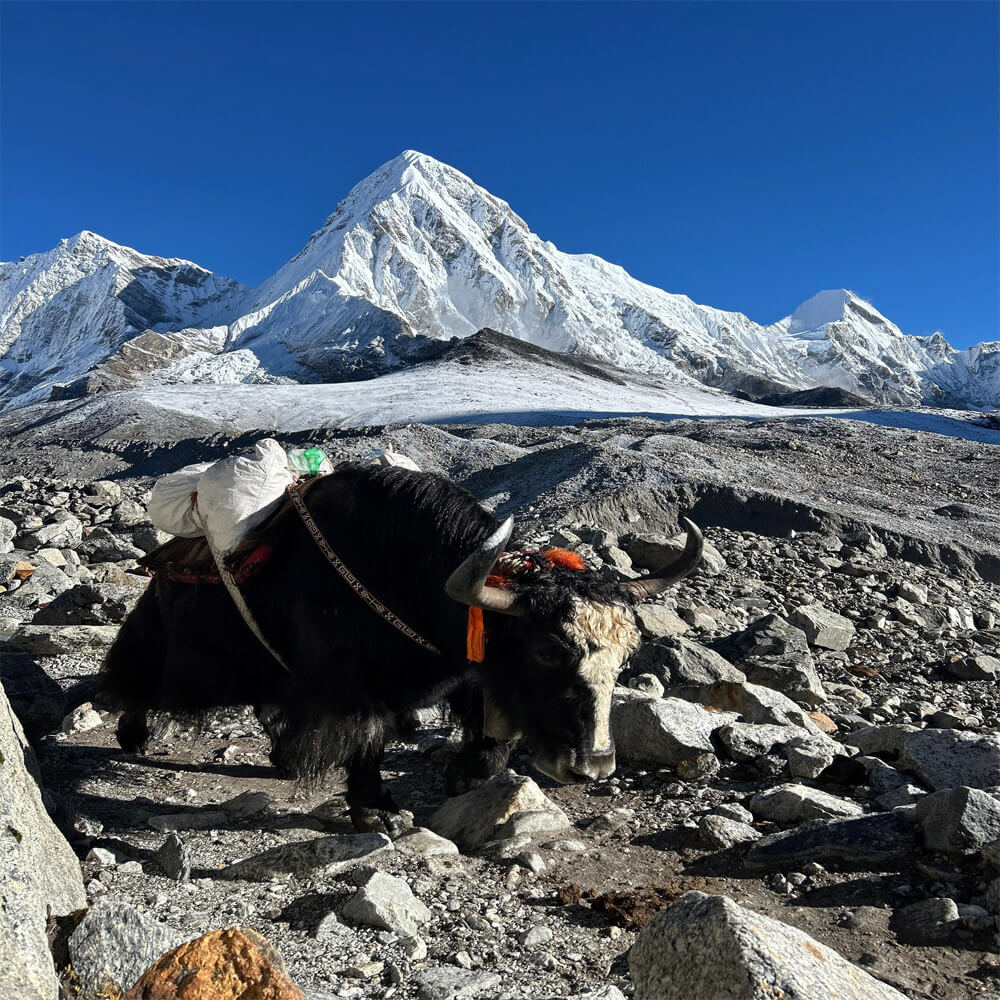
A winter sleeping trek to Everest Base Camp is only for the most determined adventurers. Winter, which lasts from December to February, brings hard circumstances that necessitate meticulous preparation, but it also provides distinct rewards for those who are willing to brave the cold.
Temperatures can drop well below freezing throughout this season, particularly at altitudes above 4,000 meters. Nights at the lodges and tea houses are particularly cold, so bring a high-quality insulated sleeping bag and warm clothing. Daytime temperatures can be cool, but clear skies often provide breathtaking views of Everest, Lhotse, and Nuptse without the haze that plagues other seasons.
Winter trekking brings less visitors, allowing for a more quiet, almost isolated experience on the mountains. Snow covers the villages and paths, giving the environment a tranquil, enchanted character. However, severe snowfall and ice conditions can make certain trails hazardous or even impassable. Trekkers must be cautious, well-prepared, and physically fit to endure long days in the cold.
Despite these hurdles, the winter EBC sleeping trek can be extremely rewarding for those seeking isolation, pure snow-covered landscapes, and breathtaking Himalayan views. Winter can offer a one-of-a-kind and amazing Everest Base Camp experience with the right equipment, careful planning, and direction from expert trekking companies.
Best season for Everest Base Camp sleeping trek
The peak season for the Everest Base Camp (EBC) sleeping trek is from March to May and late September to November. These months draw the most trekkers since the weather is often consistent, the skies are clear, and the mountain views are excellent. Clear weather makes it easier to see Everest and the surrounding Himalayan peaks, which is one of the main reasons people attempt this trek.
In the spring, daytime temperatures are mild, making trekking more comfortable, but nights at higher elevations remain frigid, necessitating the use of excellent sleeping gear. The pathways are alive with rhododendron blooming, bringing vibrant hues to the journey. It is also a popular time because many trekkers wish to avoid the monsoon rains and the harsh winter weather.
During fall, the weather is slightly cooler but extremely consistent, with little cloud cover. The visibility is superb, making it ideal for photographing and enjoying the panoramic views. Tea houses and lodges are fully operating, offering trekkers with consistent overnight lodgings along the way.
Because these are peak seasons, trails can be congested, therefore hiring tea houses in advance is suggested. Understanding this peak period allows trekkers to plan logistics, resulting in a smoother and more comfortable EBC sleeping trek experience.
Altitude and sleeping conditions Everest Base Camp
The Everest Base Camp (EBC) trek has a large altitude gain, which directly influences sleeping conditions along the way. Base Camp is located at 5,364 meters (17,598 feet), and trekkers gradually ascend via settlements such as Namche Bazaar, Dingboche, and Lobuche, enabling their bodies to acclimatize. Despite this slow approach, altitude can make it difficult to sleep, particularly over 3,500 meters. Light sleep, frequent awakening, and minor headaches are common symptoms of the body's adjustment to lower oxygen levels.
Teahouses and motels along the route offer basic overnight lodgings. Rooms are often small, shared, and furnished with modest beds, thin mattresses, and occasionally blankets. Heating is restricted, with tiny stoves in common spaces. Trekking in spring or autumn is beneficial since the nights are less severe than in winter, but temperatures can still drop well below freezing at higher elevations.
It is critical to bring a thick, insulated sleeping bag that can withstand temperatures below zero degrees. Some trekkers also wear a liner for added warmth and cleanliness. Layered clothing, wool socks, and a thick hat are ideal for cold nights. Overall, while the sleeping conditions are minimal, adequate planning and progressive acclimatization make high-altitude overnight stays manageable and allow trekkers to relax enough to safely continue their journey to EBC.
Acclimatization and sleep EBC trek
Acclimatization is an important aspect of the Everest Base Camp (EBC) sleeping trek. Because the trek progressively ascends in altitude to almost 5,300 meters at EBC your body requires time to adjust to thinner air and lower oxygen levels. Ignoring acclimatization can result in altitude sickness, which can range from minor headaches and nausea to more serious disorders such as High Altitude Pulmonary Edema (HAPE) or High Altitude Cerebral Edema (HACE).
The EBC sleeping trek itinerary includes acclimatization. Trekkers typically follow the "climb high, sleep low" strategy, which involves trekking to a higher altitude during the day and returning to a lower elevation to sleep. This allows the body to manufacture more red blood cells, which improves oxygen efficiency. Namche Bazaar, Dingboche, and Lobuche are typical acclimatization sites where trekkers rest for a day or two before continuing their ascent.
Sleeping at high altitude can be difficult. Nights are cold, and the thin air can make breathing difficult, resulting in restless sleep. Using a warm sleeping bag, staying hydrated, and avoiding alcohol or large meals before bedtime can all assist enhance sleep quality. Proper acclimatization and rest are critical for a safe and happy journey to Everest Base Camp, making each day of the trek more comfortable and gratifying.
Off-season trekking Everest Base Camp
Off-season trekking to Everest Base Camp (EBC) refers to the time between the popular spring and autumn seasons primarily winter (December to February) and monsoon summer (June to August). While many trekkers avoid these months owing to the harsh circumstances, off-season trekking can provide a unique and peaceful experience for those who are prepared.
During the winter, the paths are less congested, and the mountains typically appear crisp and clean in the brilliant sun. Temperatures, however, drop dramatically, particularly at night, frequently dipping below -15°C at higher altitudes. Snow can obstruct trails, making trekking more difficult, and some lodges may remain closed. Trekkers require sturdy cold-weather gear, insulated sleeping bags, and prior experience with high-altitude trekking.
The monsoon season brings torrential rain, landslides, and slippery slopes, making the trek dangerous and unpredictable. Clouds frequently obstruct views, and leeches or muddy pathways can challenge even the most experienced trekker. Weather delays might cause lodges to close or become overcrowded.
Despite these problems, off-season trekking has advantages, including less crowds, reduced rates, and a more quiet, real Himalayan experience. For those willing to put up with rougher conditions, it is a chance to see Everest in a calmer, more intimate situation. A safe off-season EBC trek requires proper preparation, up-to-date weather information, and flexibility in planning.
Frequently Asked Question
What is the best season to trek Everest Base Camp?
The ideal seasons are spring (March–May) and autumn (September–November). During these months, the weather is stable, skies are clear, and visibility of Everest and surrounding peaks is excellent.
Can I trek EBC during winter?
Yes, winter (December–February) is possible, but temperatures are extremely cold, trails may be snowy, and some teahouses have limited services. It’s best suited for experienced trekkers seeking solitude.
Is monsoon season suitable for EBC trekking?
Monsoon (June–August) is generally not recommended. Heavy rainfall makes trails slippery, increases landslide risk, and often reduces visibility of the mountains.
How does the season affect acclimatization?
Stable weather in spring and autumn allows safer gradual altitude gain. Cold winter conditions may make acclimatization more challenging, while wet monsoon conditions can increase fatigue.
Conclusion: Best time for Everest Base Camp Sleeping Trek
Choosing the right time for the Everest Base Camp Sleeping Trek is critical to a safe, pleasurable, and memorable journey. Spring (March-May) and autumn (September-November) are often regarded as the best seasons due to the consistent weather, clear skies, and superb visibility of Everest and its neighboring peaks. These seasons also provide pleasant temperatures for trekking and stunning natural landscapes, such as blossoming rhododendrons in the spring. Winter provides seclusion but also brings harsh cold and snow, whilst the monsoon season presents risks of rain, landslides, and poor visibility.
Planning with our competent operator, Nepal Trekking Routes, guarantees that you receive correct direction, permits, acclimatization tactics, and logistical support, resulting in a safe, well-organized, and amazing Himalayan adventure.

